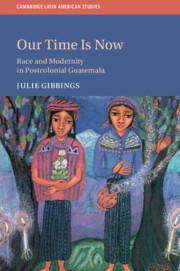Book contents
- Our Time Is Now
- Cambridge Latin American Studies
- Our Time Is Now
- Copyright page
- Dedication
- Contents
- Maps, Figures, and Tables
- Acknowledgments
- Introduction
- Part I Translating Modernities
- Part II Aspirations and Anxieties of Unfulfilled Modernities
- 5 On the Throne of Minerva
- 6 Freedom of the Indian
- 7 Possessing Tezulutlán
- 8 Now Owners of Our Land
- Conclusion
- Glossary
- Index
- Cambridge Latin American Studies (continue from page ii)
6 - Freedom of the Indian
Maya Rights and Citizenship in a Democratic Experiment, 1920–1931
from Part II - Aspirations and Anxieties of Unfulfilled Modernities
Published online by Cambridge University Press: 01 July 2020
- Our Time Is Now
- Cambridge Latin American Studies
- Our Time Is Now
- Copyright page
- Dedication
- Contents
- Maps, Figures, and Tables
- Acknowledgments
- Introduction
- Part I Translating Modernities
- Part II Aspirations and Anxieties of Unfulfilled Modernities
- 5 On the Throne of Minerva
- 6 Freedom of the Indian
- 7 Possessing Tezulutlán
- 8 Now Owners of Our Land
- Conclusion
- Glossary
- Index
- Cambridge Latin American Studies (continue from page ii)
Summary
In the aftermath of this political upheaval, Guatemalans embarked on a tenuous democratic experiment across the 1920s. A group of radicalized Q’eqchi’s formed a branch of the Unionist Party and demanded that the state end forced wage labor, abolish debt contracts, and grant citizenship to all Mayas. For the next decade, Q’eqchi’s engaged in labor strikes and land invasions, which articulated another history of time and space based on memories of prior possession and land alienation. At the same time, urban reformers and intellectuals, including Miguel Angel Asturias, increasingly sought to move beyond the failed ladino nation-state that had taken power in 1871. To do so, they looked to Alta Verapaz to imagine a new nation based on modernization through prosperous coffee plantations and European immigration, which had yielded an alternative mestizaje project based on interracial mixing between German immigrants and Mayas. Guatemala’s decade-long democratic experiment came to an end with the Great Depression and Central America’s 1932 Red Scare.
Keywords
- Type
- Chapter
- Information
- Our Time is NowRace and Modernity in Postcolonial Guatemala, pp. 231 - 267Publisher: Cambridge University PressPrint publication year: 2020

